Palatine Joseph remains a somewhat legendary figure of the Hungarian Reform Period (1825–1848), who accelerated the development of Hungary and Budapest. The statesman served as Palatine for over five decades. The "most Hungarian Habsburg", as he was known, founded the Habsburg Palatine Crypt in Buda Castle, which is now the only section of the palace that survived World War II and the subsequent reconstruction unchanged.
Henrietta Kiss, guide of the tour tells participants about the life of Palatine Joseph (Photo: Róbert Juharos/pestbuda.hu)
Henrietta Kiss, a member of the team at Várkapitányság, served as the guide for the walk in Buda Castle entitled Habsburgok és Holtak ('Habsburgs and the Deceased'). She added several interesting stories to the beautiful surroundings of the walk. For example, she explained how Palatine Joseph was connected to the Royal Gardens: As was tradition in the House of Habsburg, each young archduke was required to learn a civilian trade. The young Palantine to-be chose botany as his field. His diverse knowledge and love of gardens are to thank for the creation of Margit Island, the City Park, and the development of the Palace gardens.
Henrietta Kiss also shared details of what the Palace Gardens were like when once decorated with over 300 types of roses. The last remaining messenger of this age is a Japanese pagoda tree next to the southern Rondelle. The tree may even have been planted during the Palatine's life.
The Japanese pagoda tree still stands next to the southern Rondelle. Also called the Great tree it was likely planted during palatine Joseph's lifetime and survived the destruction of World War II (Photo: Zsófia Viczián/pestbuda.hu)
Portrait of Palatine Joseph by Miklós Barabás. The statesman lived between 1776 and 1847 and was said to have been born a Habsburg but died a Hungarian.
The guide also added that upon arriving in Buda, Palatine Joseph quickly became a representative of Hungarian interests in Vienna. Later the imperial court eyed him with growing suspicion, and the Palatine was forced out of day-to-day politics and increasingly focused on urban development and supporting culture. This is the base of his legacy.
While the Palatine excelled in the creation of academic, scientific, cultural and social institutions of Pest and Buda, he endured great losses in his private life. Two of his three wives, four of his eight children died.
His first wife, Alexandra Pavlovna, the daughter of the Russian Tsar, died in childbirth after a short but happy marriage. Their daughter, Archduchess Paulina, also died. Similarly, his second wife, Princess Hermine of Anhalt-Bernburg-Schaumburg-Hoym also died in childbirth. His third wife, Duchess Maria Dorothea of Württemberg, however, survived her husband and cared for him in his final weeks and days.
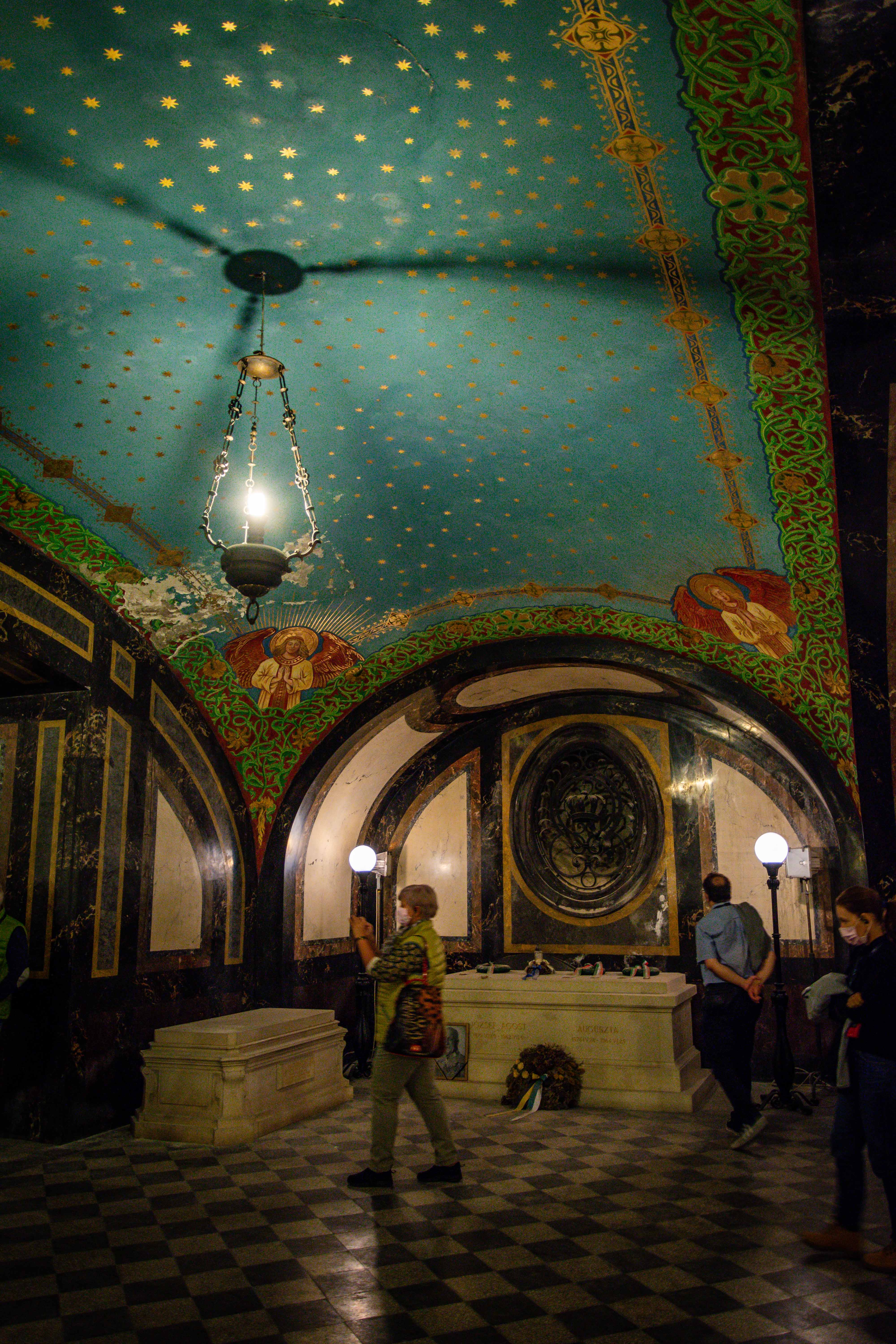
The central hall of the crypt (Photo: Róbert Juharos/pestbuda.hu)
Palatine Joseph and his family occupied the south wing of the Royal Palace. The crypt was originally part of the Saint Sigismund palace chapel, which was consecrated in 1769. The chapel was severely damaged in the Second World War and never rebuilt. However, its crypt survived for posterity. Today, it can be accessed from the exhibition spaces of the National Gallery, through a secret door.
A marble statue of Palatine Joseph dominates the three-room crypt by György Zala (Photo: Róbert Juharos/pestbuda.hu)
Initially, the crypt served as a burial place for the Mary Ward's nuns and palace staff but later fell into disuse. The palatine began using the tomb following the family tragedies mentioned above: he buried his dead children here in 1820 and 1837. Following these burials, he requested official permission from the Viennese court to convert the tomb into a family crypt. The founder of the Hungarian branch of the House of Habsburg became its sixth "inhabitant" in 1847.
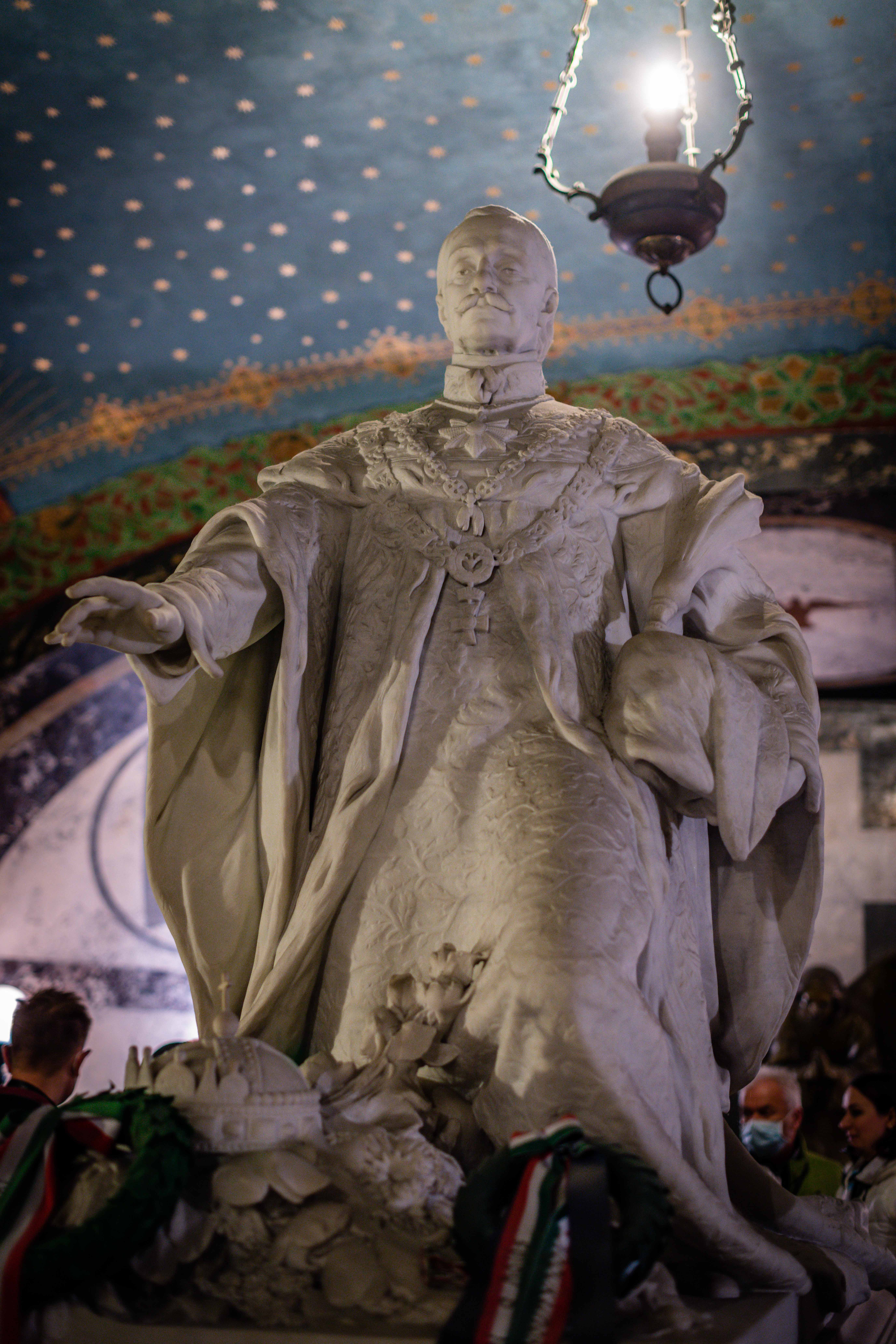
Palatine Joseph extends his protective arm above the Holy Crown of Hungary in the statue by György Zala (Photo: Róbert Juharos/pestbuda.hu)
At the turn of the century, Miklós Ybl was commissioned to re-plan the crypt, after his death, Alajos Hauszmann, who was tasked with renovating the entire palace complex designed changes. Work dragged on for decades until the crypt took its final form, visible to the present day.
The Habsburg Palatine Crypt is divided into three rooms. The first is the chapel, the second the funeral hall. A plaque here contains the names of the earliest occupants of the current crypt. Members of the House of Habsburg who died after 1945 are also buried here, the famous Archduke Joseph August among them.
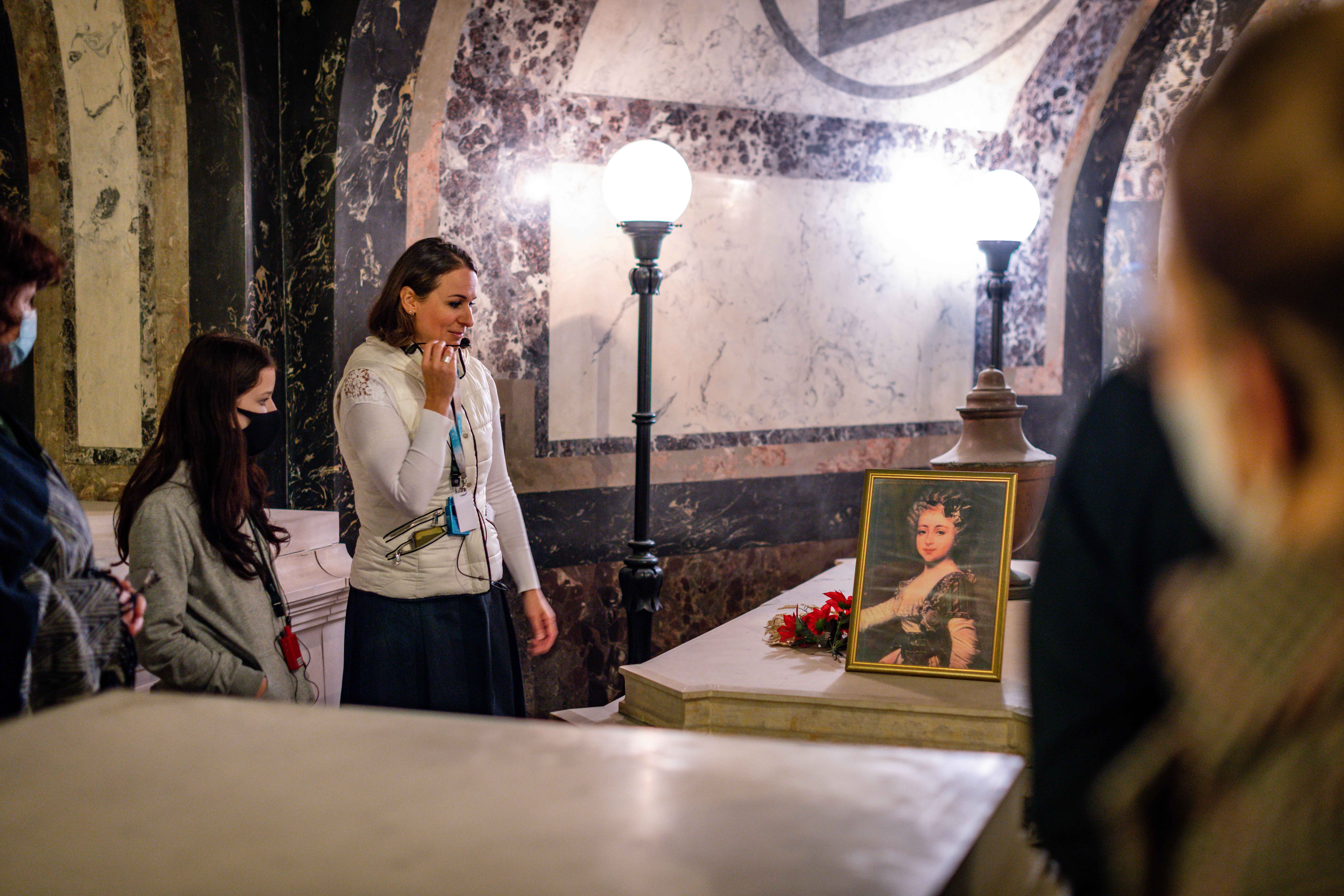
A great deal of interest remains about Palatine Joseph's first wife, Alexandra Pavlovna, in her homeland, Russia (Photo: Róbert Juharos/pestbuda.hu)
The sarcophagus of Palatine Joseph is the central feature of the third room. Behind it stands the bronze urn containing the organs of the deceased, a unique element of Habsburg burial rites. The three sarcophagi of his wives surround his grave. However, his first wife was eventually buried in the Pravoslavic Chapel in Üröm, and not the crypt.
Floor plan of the internal room of the Palatine crypt (Source: Péter Schmidt: A Habsburg nádori kripta)
The sarcophagus of Palatine Joseph's granddaughter. Elizabeth Klementina died at only 10-months old. The marble statue was created by Alajos Strobl (Photo: Róbert Juharos/pestbuda.hu)
The colourful, art nouveau ceiling frescoes of the crypt are also of note. Depicting a starry sky, angels appear in the corners of the arches.
Our guide also retold the shocking history of how the crypt was robbed several times during the war and after 1945. In the 70s and 80s, anthropologists and medical experts conducted studies of the bodies of the deceased. It is from these that posterity has a better understanding of the lives led by those buried here, and the previously unknown causes of their death's.
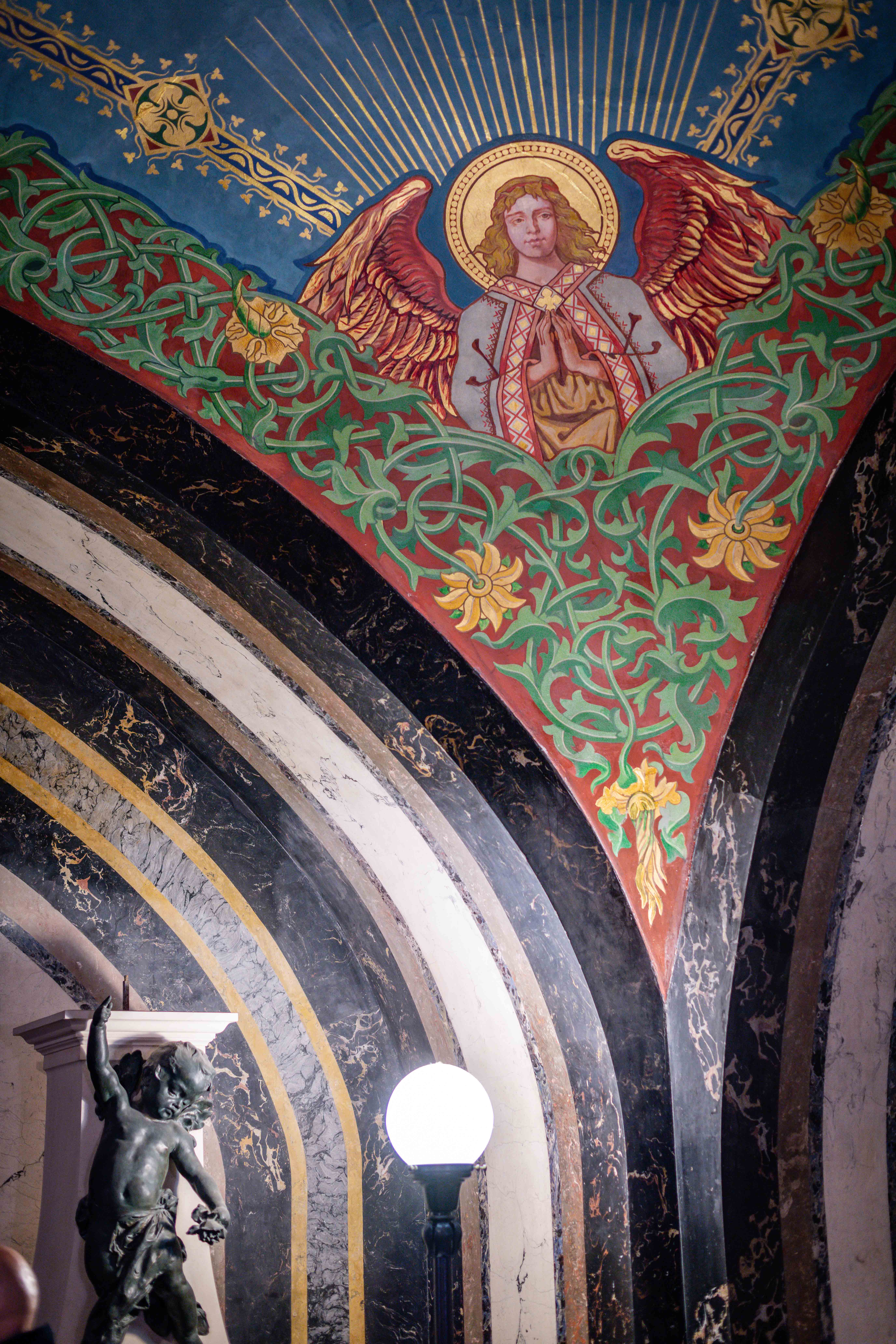
An art Nouveau angel looks down from the ceiling of the Palatine Crypt (Photo: Róbert Juharos/pestbuda.hu)
Following its renovation, the crypt was reopened on 3 October 1987. Eleven descendants of Palatine Joseph attended its consecration. In 1992 several remains were relocated to the crypt from Austria and Germany. Another urn was placed in the crypt in the 2010s. Today, the tomb houses the remains of 2 members of the family.
Descendants still regularly visit the family burial site. The chapel is a site consecrated for Roman Catholic Mass; thus the dead are commemorated with a ceremony on these occasions.
The wing of the building closed by the Mátyás Fountain once housed the Saint Sigismund palace chapel. The tall windows of the chapel are clearly visible on archive photographs. The crypt lies beneath this wing of the palace complex.
At the end of the tour, the participants return from the past to the present-day on the steep stairs of the crypt. The crypt of the Hungarian branch of the House of Habsburg is one of the most well-hidden gems of Budapest. Yet, we were given a glimpse into not only the lives but the death of its inhabitants.
The crypt can only be visited as part of a guided tour. However, due to the restrictions put in place on 10 November all thematic tours in the Castle have been cancelled. Once the situation improves and the National Hauszmann Program can restart these walking tours, the information will be published on the Castle Garden Bazaar website.
Cover photo: Interior of the Palatine Crypt in Buda Castle (Photo: Róbert Juharos/pestbuda.hu)

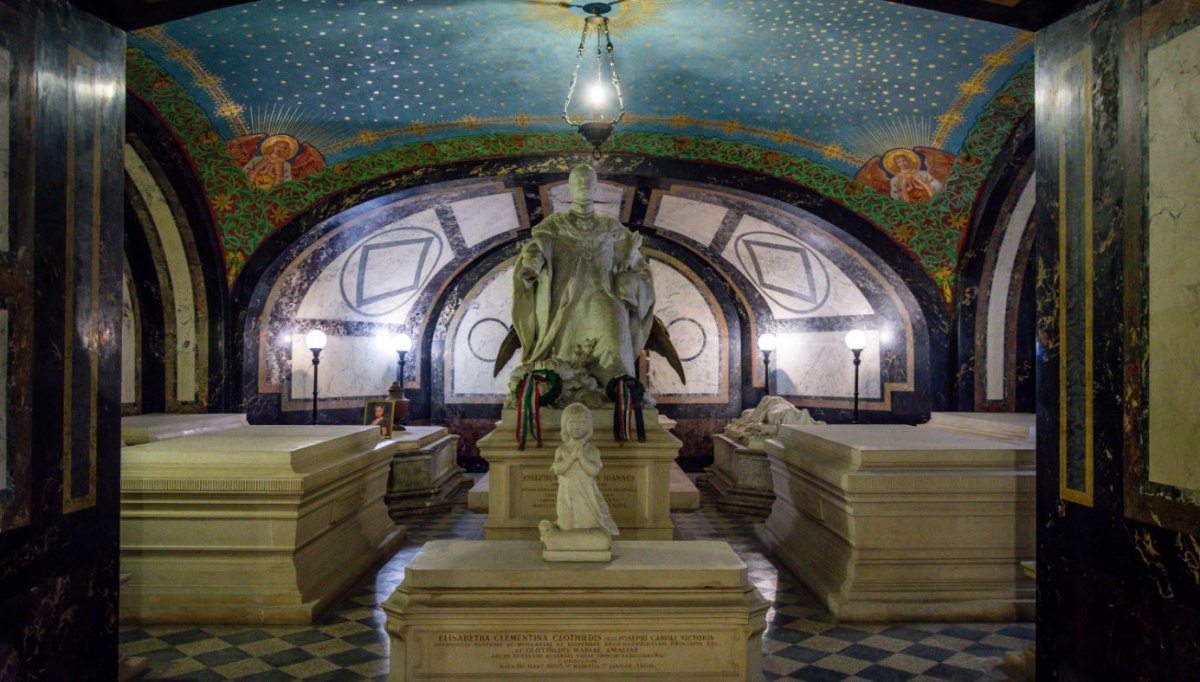



































Hozzászólások
Log in or register to comment!
Login Registration